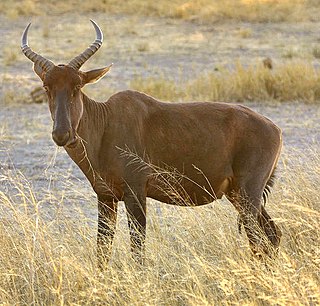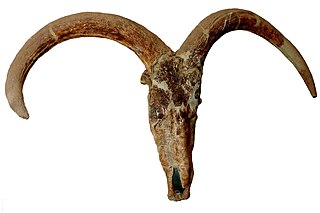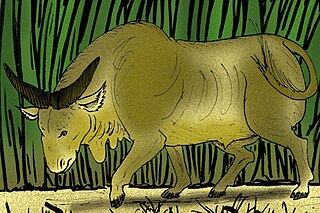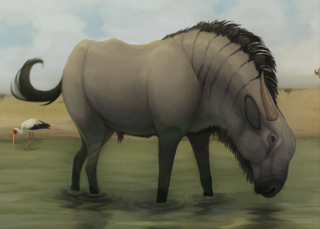
Wildebeest, also called gnu, are antelopes of the genus Connochaetes and native to Eastern and Southern Africa. They belong to the family Bovidae, which includes true antelopes, cattle, goats, sheep, and other even-toed horned ungulates. There are two species of wildebeest: the black wildebeest or white-tailed gnu, and the blue wildebeest or brindled gnu.

The term antelope refers to numerous extant or recently extinct species of the ruminant artiodactyl family Bovidae that are indigenous to most of Africa, India, the Middle East, Central Asia, and a small area of Eastern Europe. Antelopes do not form a monophyletic group, as some antelopes are more closely related to other bovid groups, like bovines, goats, and sheep, than to other antelopes.

The Bovidae comprise the biological family of cloven-hoofed, ruminant mammals that includes cattle, yaks, bison, buffalo, antelopes, sheep and goats. A member of this family is called a bovid. With 143 extant species and 300 known extinct species, the family Bovidae consists of 11 major subfamilies and thirteen major tribes. The family evolved 20 million years ago, in the early Miocene.

The steppe bison or steppe wisent is an extinct species of bison. It was widely distributed across the mammoth steppe, ranging from Western Europe to eastern Beringia in North America during the Late Pleistocene. It is ancestral to all North American bison, including ultimately modern American bison. Three chronological subspecies, Bison priscus priscus, Bison priscus mediator, and Bison priscus gigas, have been suggested.

The subfamily Alcelaphinae, of the family Bovidae, contains the wildebeest, tsessebe, topi, hartebeest, blesbok and bontebok, and several other related species. Depending on the classification, there are 6–10 species placed in four genera, although Beatragus is sometimes considered a subgenus of Damaliscus, while Sigmoceros is sometimes considered for the Lichtenstein's hartebeest.

The hirola, also called the Hunter's hartebeest or Hunter's antelope, is a critically endangered antelope species found as of now, only in Kenya along the border of Somalia. It was first described by the big game hunter and zoologist H.C.V. Hunter in 1888. It is the only living member of the genus Beatragus, though other species are known from the fossil record. The global hirola population is estimated at 300–500 animals and there are none in captivity. According to a document produced by the International Union for Conservation of Nature "the loss of the hirola would be the first extinction of a mammalian genus on mainland Africa in modern human history".

The hartebeest, also known as kongoni or kaama, is an African antelope. It is the only member of the genus Alcelaphus. Eight subspecies have been described, including two sometimes considered to be independent species. A large antelope, the hartebeest stands just over 1 m at the shoulder, and has a typical head-and-body length of 200 to 250 cm. The weight ranges from 100 to 200 kg. It has a particularly elongated forehead and oddly-shaped horns, a short neck, and pointed ears. Its legs, which often have black markings, are unusually long. The coat is generally short and shiny. Coat colour varies by the subspecies, from the sandy brown of the western hartebeest to the chocolate brown of the Swayne's hartebeest. Both sexes of all subspecies have horns, with those of females being more slender. Horns can reach lengths of 45–70 cm (18–28 in). Apart from its long face, the large chest and the sharply sloping back differentiate the hartebeest from other antelopes. A conspicuous hump over the shoulders is due to the long dorsal processes of the vertebrae in this region.

Myotragus is an extinct genus of goat-antelope in the tribe Caprini which lived on the Balearic Islands of Mallorca and Menorca in the western Mediterranean until its extinction around 4,500 years ago. The fossil record of Myotragus on the Balearic Islands extends over 5 million years back to the early Pliocene on Mallorca, where it presumably arrived after the evaporation of the Mediterranean Sea during the Messinian Salinity Crisis.

The European wild ass or hydruntine is an extinct equine from the Middle Pleistocene to Late Holocene of Europe and West Asia, and possibly North Africa. It is a member of the subgenus Asinus, and closely related to the living Asiatic wild ass. The specific epithet, hydruntinus, means from Otranto.

Pelorovis is an extinct genus of African wild cattle which existed during the Pleistocene epoch. The best known species is Pelorovis oldowayensis from Olduvai Gorge in Tanzania, from the Early Pleistocene. The species "Pelorovis" antiquus from the Late Pleistocene-Holocene has since been moved into Syncerus, the same genus as living African buffalo.

Bison latifrons, also known as the giant bison or long-horned bison, is an extinct species of bison that lived in North America during the Late Pleistocene epoch ranging from southern Canada to Mexico. It is noted for large body size and its distinctive long horns.

The red hartebeest, also called the Cape hartebeest or Caama, is a subspecies of the hartebeest found in Southern Africa. More than 130,000 individuals live in the wild. The red hartebeest is closely related to the tsessebe and the topi.

Makapania is an extinct genus of large caprine or ovibovine from the Pliocene and Pleistocene of southern and East Africa. It is remarkable in that its horns were positioned laterally. Its body weight is estimated to have been about 263 kg.

"Ekbletomys hypenemus" is an extinct oryzomyine rodent from the islands of Antigua and Barbuda, Lesser Antilles. It was described as the only species of the subgenus "Ekbletomys" of genus Oryzomys in a 1962 Ph.D. thesis, but that name is not available under the International Code of Zoological Nomenclature and the species remains formally unnamed. It is currently referred to as "Ekbletomys hypenemus" in the absence of a formally available name. The species is now thought to be extinct, but association with introduced Rattus indicates that it survived until before 1500 BCE on Antigua.

Syncerus antiquus is an extinct species of buffalo from the Late Pleistocene and Holocene of Africa. It was one of the largest species in its family, potentially weighing up to 2,000 kilograms (4,400 lb). Due to this fact, it is sometimes known as the African giant buffalo. The time of its extinction is of debate; Syncerus antiquus either became extinct at the end of the Late Pleistocene about 12,000 years ago or during the Holocene, some 4,000 years ago.
Damalborea is an extinct genus of alcelaphine bovid. It was first named by Alan W. Gentry in 2010, and the type species is Damalborea elisabethae. It is known from the holotype AL 208–7, a skull with horn cores collected from the Middle Pliocene Hadar Formation Member SH-3 of Ethiopia. In addition, a fossils of this or a closely related species were collected from Aramis, Wee-ee and Maka localities in the Middle Awash deposits, lower and upper units of the Laetolil Beds, as well as Tulu Bor Member and an unknown horizon of the Koobi Fora Formation. Geraads, Bobe & Reed (2012) assigned all Damalborea specimens from the Basal Member and Sidi Hakoma member of the Hadar Formation to the species D. elisabethae; in addition, the authors named the second species, Damalborea grayi, described on the basis of fossils from the Denen Dora member of the Hadar Formation. Damalborea was a moderately large alcelaphine with high and narrow skull proportions.

Nelson Bay Cave also known as Wagenaar's Cave is a Stone Age archaeological site located in the Robberg Nature Reserve on the Robberg Peninsula and facing Nelson's Bay near Plettenberg Bay in South Africa, and showing evidence of human occupation as far back as 125,000 years ago.

Rusingoryx is a genus of extinct alcelaphine bovid artiodactyl closely related to the wildebeest. It contains only one species, R. atopocranion, that lived on the plains of Kenya during the Pleistocene. It was originally named as a species of Megalotragus.
Gazella atlantica, the Atlantic gazelle, is an extinct species of gazelle that lived in Northwest Africa during the Late Pleistocene.
Numidocapra is an extinct genus of bovid from the Pleistocene of Africa.


















